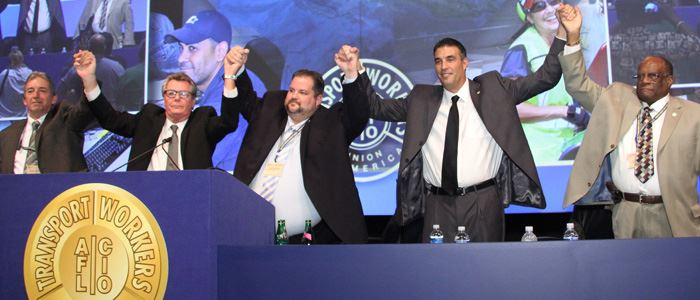Transport Workers' New Leaders Double Down on Political Action

The Transport Workers Union's new officers are mostly its old officers. Their platform emphasized more focus on getting the right people elected and the right legislation passed. Photo: TWU.
Since the 2009 convention of the Transport Workers Union, which represents workers in urban mass transit, railroads, utilities, and airlines, TWU members have seen funding cuts to mass transit; bankruptcy at American Airlines, which led to the loss of thousands of jobs and cuts to pensions; attempted raids by the Teamsters and the Aircraft Mechanics Fraternal Association; a joint representation agreement with the Machinists once American and USAir have merged; and a move by President James Little to affiliate with the Communications Workers.
The dissatisfaction of many local presidents with how the TWU handled these matters jelled early this year into an opposition slate from within the union’s administration.
The TWU’s September convention could have been a chance for honest reflection and an open discussion of how to meet the challenges facing the union. A contested election could have provided members, or at least delegates, with competing ideas for how to move the union forward.
But by the time the convention was called to order in Las Vegas, the election had already been decided. The challengers had won, and they had done so without having to lead a difficult, and potentially painful, assessment of the state of the union and what was to be done about it.
In May, Harry Lombardo, the TWU’s executive vice president, who started as a cleaner and rose through the ranks at TWU Local 234 in Philadelphia, put together a slate to challenge Little at the convention. The slate included three other senior officers (all were elected with Little in 2009 and have been on the International’s staff) plus John Samuelsen, president of TWU 100 (representing bus and subway workers in New York City and, at 39,000 members, by far the TWU’s largest local), for executive vice president.
Since the election would be decided by fewer than 400 convention delegates, not the entire membership of 115,000, the Lombardo slate ran a campaign that targeted local presidents and their concerns. Little announced his retirement. A slate of his supporters, put together to oppose Lombardo’s, quickly fizzled.
Limited Platform
Lombardo’s strategy worked, but it did not engage members. And it shied away from difficult issues about how to build the union’s power. In fact, the campaign limited itself to four points: 1) more consultation with local presidents, 2) build structures that bring locals together, 3) straighten out the TWU’s finances, and 4) provide more training and support to locals in their contract negotiations.
The second point was the new leaders’ central strategy. Their convention resolution called for “Building the Work of the State Conferences,” which are meetings of local presidents or their designees from TWU locals in a given state.

SUPPORT LABOR NOTES
BECOME A MONTHLY DONOR
Give $10 a month or more and get our "Fight the Boss, Build the Union" T-shirt.
Throughout the convention, the state conferences were promoted as the way to build TWU’s power by bringing together the resources of several locals in pursuit of common goals. Although the New York and New Jersey state conferences helped mobilize aid for members hit by Hurricane Sandy and the tornadoes in Oklahoma, it was clear that the conferences’ primary purpose will be to decide on electoral and legislative priorities.
If you think, as one delegate expressed it, that “we have to get the right people elected and the right legislation passed to get our power back,” then putting these state conferences at the center of the union’s strategy might make sense. If, on the other hand, you think that power comes from building the union’s presence on the job in ways that increase members’ ability to stand up to the boss, then the state conferences have little to offer.
We Voted for That Last Time
Despite remarks from the podium about the need to learn from our past, there was little of that in evidence. For example, the delegates passed a resolution critical of the large amount spent on full-time staff in TWU’s organizing department. It called for training a pool of local officers and members who could be pulled off the job as needed, as the key to the union’s organizing strategy.
But the 2009 Convention had passed a similar resolution to train volunteer member organizers, also as the key to TWU’s organizing strategy. What happened to that program? Did we learn anything from it that we can apply?
The only time the proceedings went off the script was when a delegate from Local 100 spoke about how the actions of the national union during the local’s 2005 strike violated fundamental notions of union solidarity. The international had issued a statement instructing members to return to work. He proposed an amendment that repudiated the position taken by the international and pledged the union’s full support to any local on strike in the future.
Lombardo, who was chairing the convention, said he’d rather wait and have a thorough discussion later about what had led to the statement. But he allowed the discussion to continue. In a standing vote, about two-thirds of the delegates voted in favor.
With a clean sweep of the five top offices, the 11 vice president slots, and 40 executive board seats, the Lombardo team now has the opportunity—and challenge—to make good on its pledge to “restore pride in the TWU and revive its fighting spirit.” It’s going to take more than improved consultation with local presidents and expanding the role of state conferences.
Steve Downs is chair of the Train Operators Division of TWU Local 100 in New York and was a delegate to the convention.



